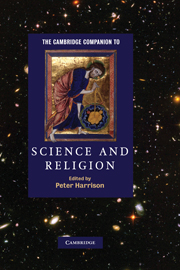Book contents
- Frontmatter
- Introduction
- Part I Historical interactions
- Part II Religion and contemporary science
- 6 Scientific creationism and intelligent design
- 7 Evolution and the inevitability of intelligent life
- 8 God, physics and the Big Bang
- 9 Psychology and theology
- 10 Science, bioethics and religion
- Part III Philosophical perspectives
- A guide to further reading
- Index
10 - Science, bioethics and religion
from Part II - Religion and contemporary science
Published online by Cambridge University Press: 28 July 2010
- Frontmatter
- Introduction
- Part I Historical interactions
- Part II Religion and contemporary science
- 6 Scientific creationism and intelligent design
- 7 Evolution and the inevitability of intelligent life
- 8 God, physics and the Big Bang
- 9 Psychology and theology
- 10 Science, bioethics and religion
- Part III Philosophical perspectives
- A guide to further reading
- Index
Summary
In this chapter I will examine the relationship between religion and science in debates over issues having to do with the human body from the 1960s to the present. These are now generally called bioethical debates, and these debates have been a primary location of interaction between religion and science from the mid-twentieth century forward. While the ability of scientists to intervene in the human body has obviously been increasing for centuries, in the 1960s this ability was perceived to have taken a quantum leap. In 1953 the structure of DNA had been discovered, suggesting to many in the 1960s that scientists would soon be able to control the genetic constitution of the human species through human genetic engineering. While kidneys had been transplanted for a number of years, 1967 saw the first heart transplant, which in turn led to more organs being transplanted. Whereas historically a person was considered dead when their heart and breathing stopped, the invention of artificial respiration, coupled with the need for transplantable organs, led in the 1960s to novel questions about who was really dead and therefore could be taken off life-support. While abortion had been practised for millennia, by the mid-1960s women could, for the first time, find out the genetic characteristics of the foetus through amniocentesis and decide, to a limited extent, what kind of child they would have. In 1969 scientists in England created the first embryo in a test-tube, which would later lead to the first 'test-tube baby' in the late 1970s.
- Type
- Chapter
- Information
- The Cambridge Companion to Science and Religion , pp. 207 - 226Publisher: Cambridge University PressPrint publication year: 2010



